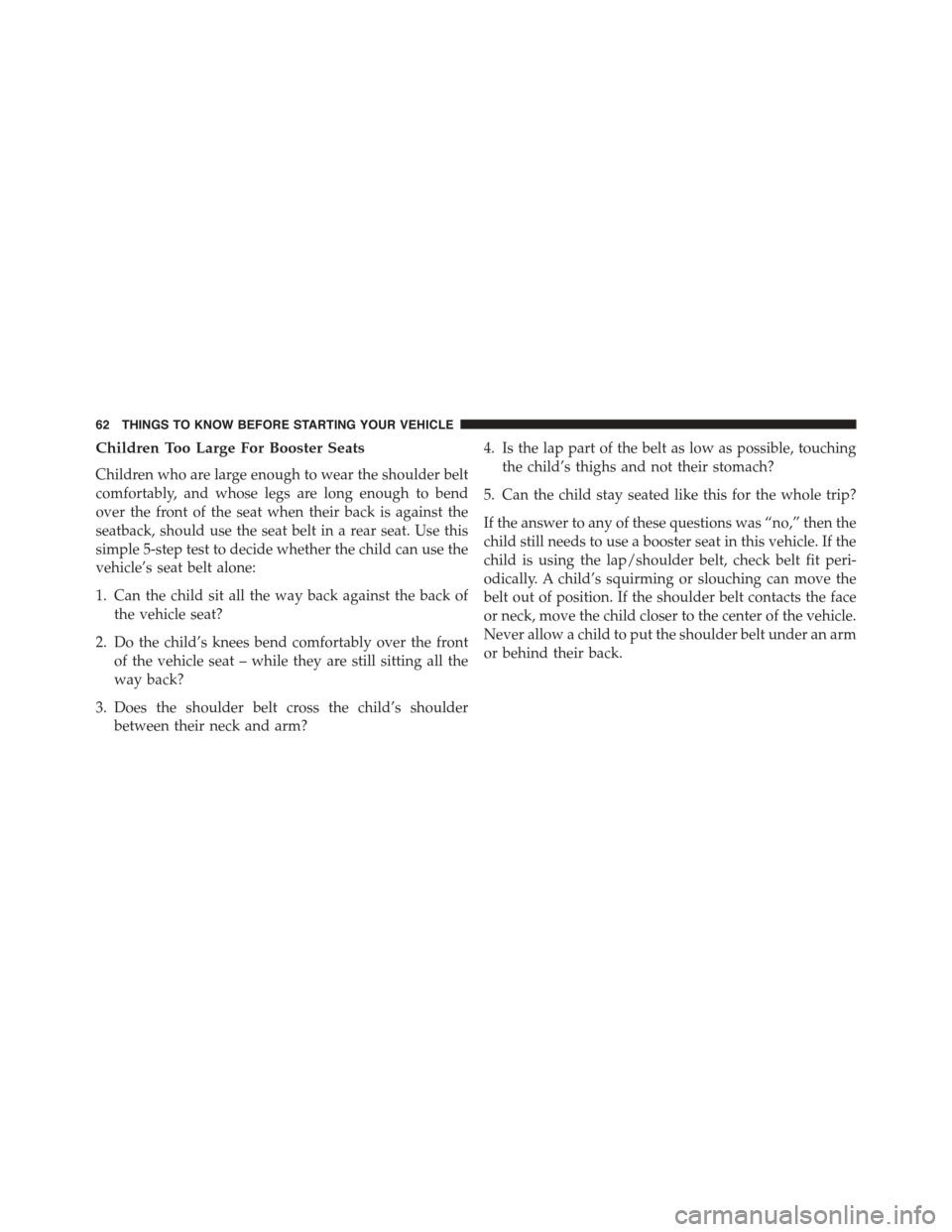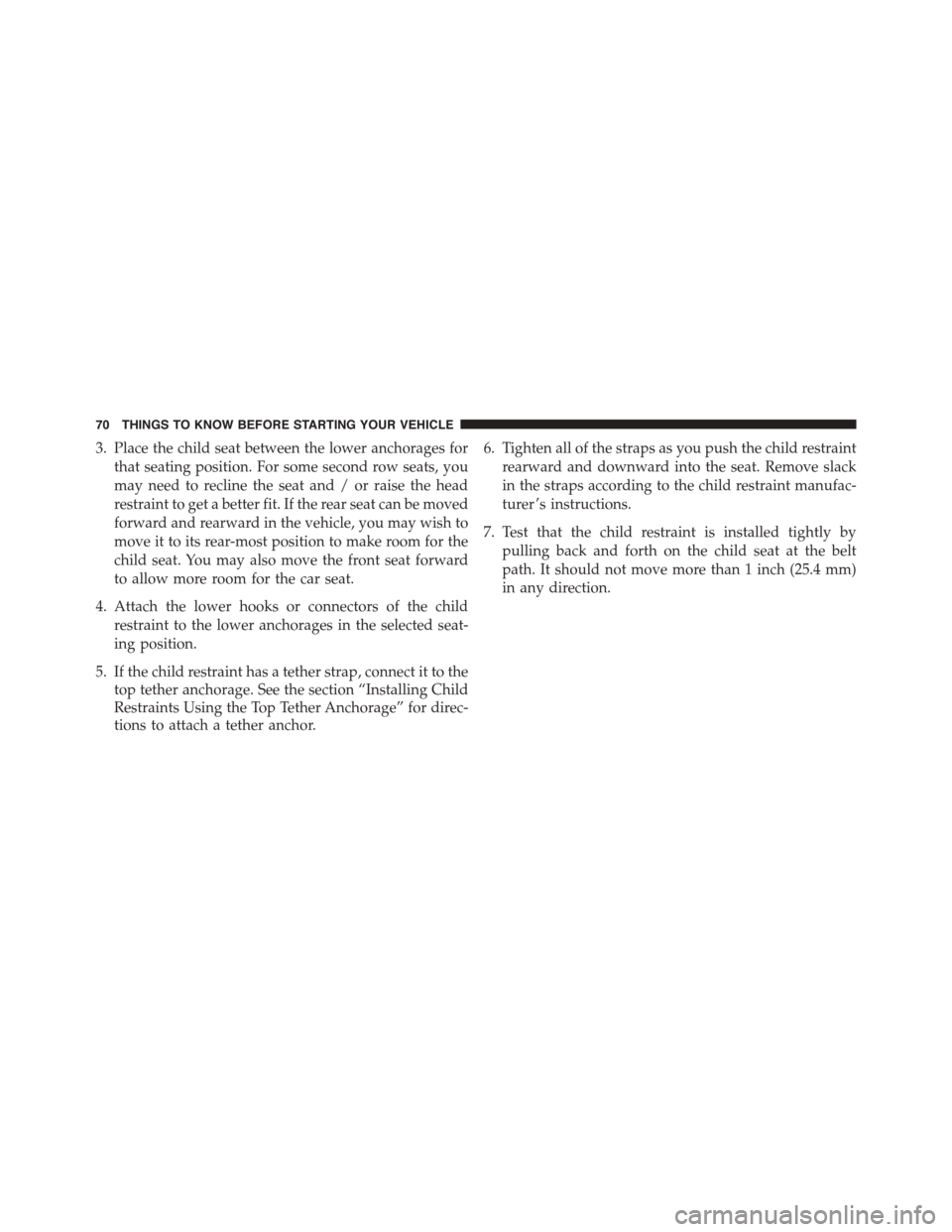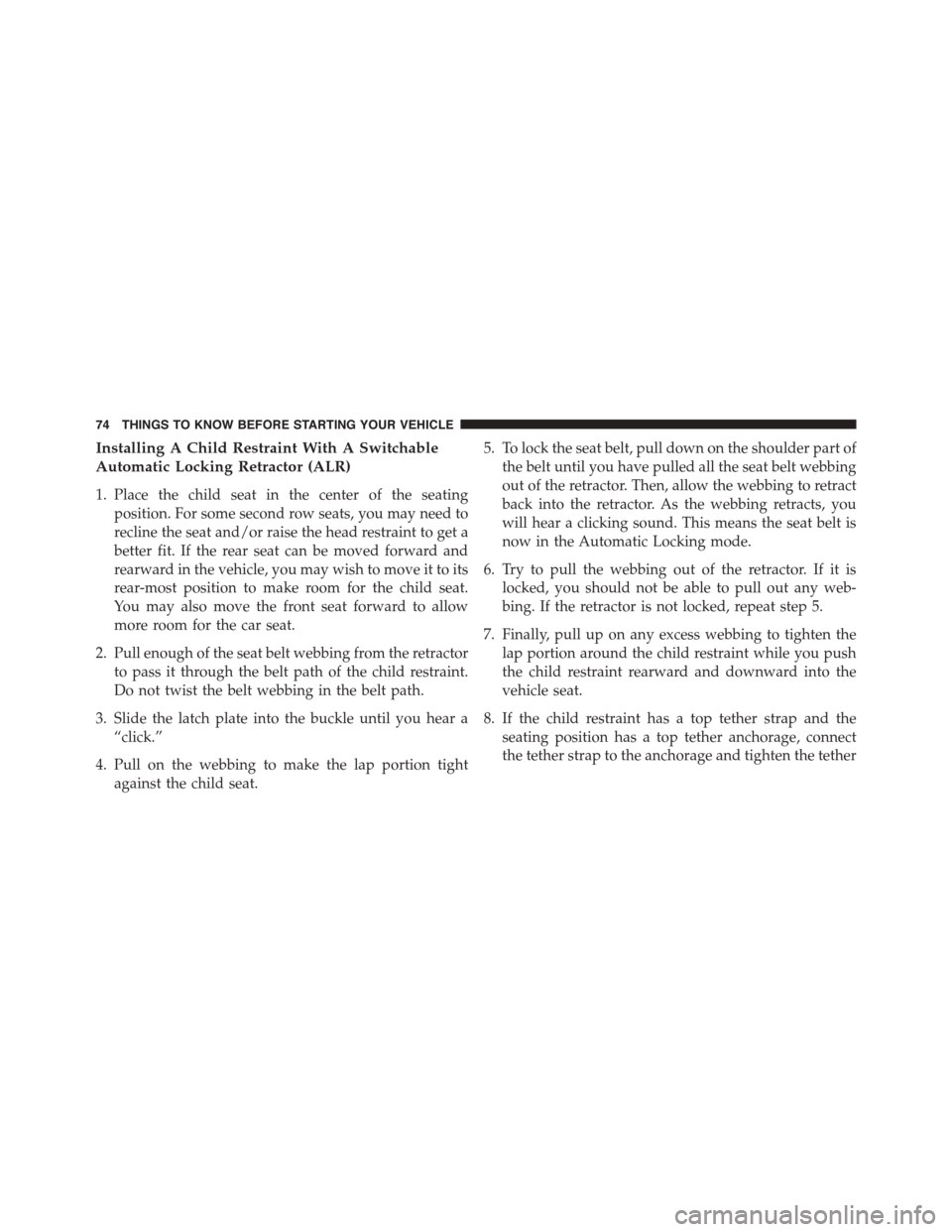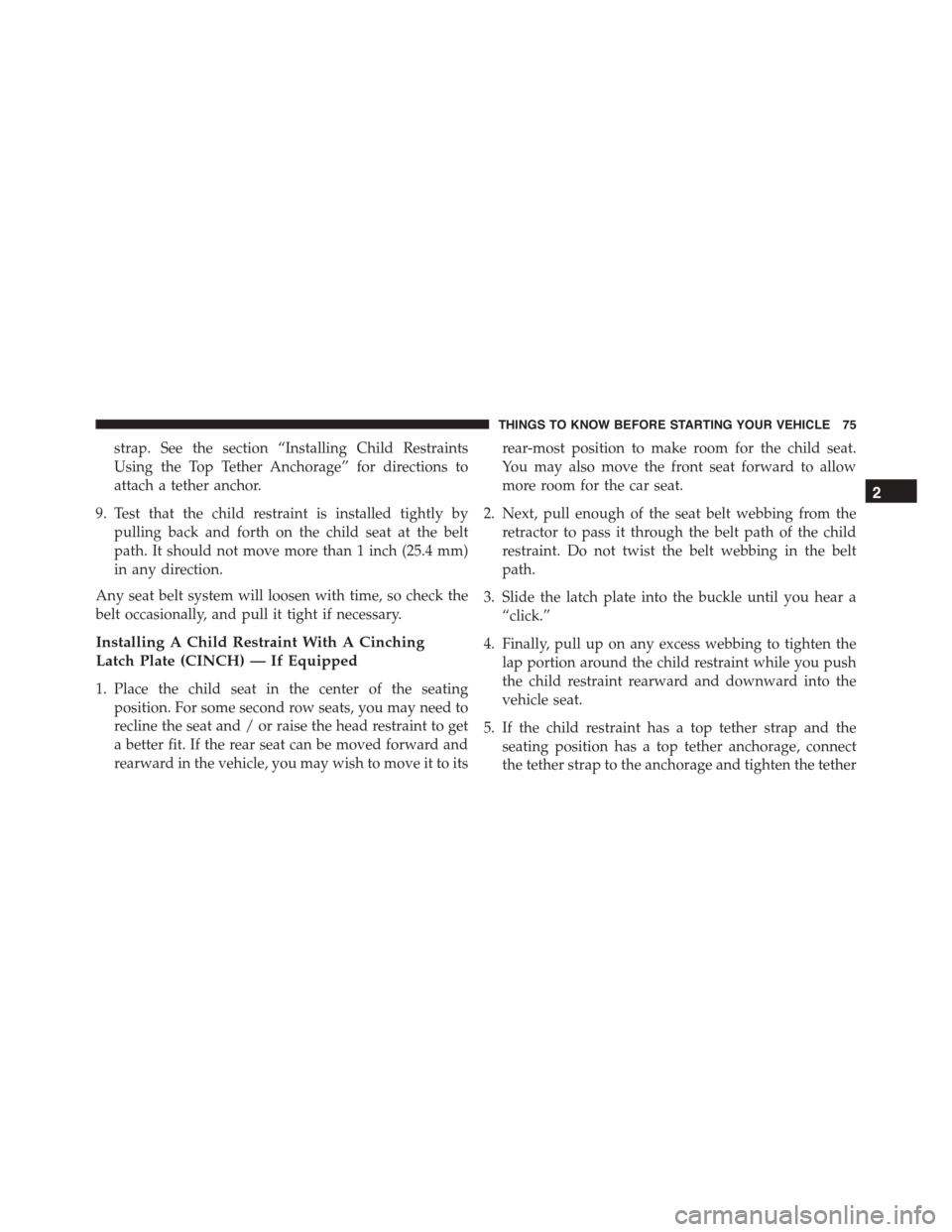Page 64 of 392

Children Too Large For Booster Seats
Children who are large enough to wear the shoulder belt
comfortably, and whose legs are long enough to bend
over the front of the seat when their back is against the
seatback, should use the seat belt in a rear seat. Use this
simple 5-step test to decide whether the child can use the
vehicle’s seat belt alone:
1. Can the child sit all the way back against the back of
the vehicle seat?
2. Do the child’s knees bend comfortably over the front
of the vehicle seat – while they are still sitting all the
way back?
3. Does the shoulder belt cross the child’s shoulder
between their neck and arm?
4. Is the lap part of the belt as low as possible, touching
the child’s thighs and not their stomach?
5. Can the child stay seated like this for the whole trip?
If the answer to any of these questions was “no,” then the
child still needs to use a booster seat in this vehicle. If the
child is using the lap/shoulder belt, check belt fit peri-
odically. A child’s squirming or slouching can move the
belt out of position. If the shoulder belt contacts the face
or neck, move the child closer to the center of the vehicle.
Never allow a child to put the shoulder belt under an arm
or behind their back.
62 THINGS TO KNOW BEFORE STARTING YOUR VEHICLE
Page 66 of 392
Lower Anchors and Tethers for Children (LATCH)
Restraint System
Your vehicle is equipped with the child restraint anchor-
age system called LATCH, which stands for Lower
Anchors and Tethers for CHildren. The LATCH system
has three vehicle anchor points for installing LATCH-
equipped child seats. There are two lower anchorages
located at the back of the seat cushion where it meets the
seatback and one top tether anchorage located behind the
seating position. These anchorages are used to install
LATCH-equipped child seats without using the vehicle’s
seat belts. Some seating positions may have a top tether
anchorage but no lower anchorages. In these seating
positions, the seat belt must be used with the top tether
anchorage to install the child restraint. Please see the
following table for more information.
64 THINGS TO KNOW BEFORE STARTING YOUR VEHICLE
Page 72 of 392

3. Place the child seat between the lower anchorages for
that seating position. For some second row seats, you
may need to recline the seat and / or raise the head
restraint to get a better fit. If the rear seat can be moved
forward and rearward in the vehicle, you may wish to
move it to its rear-most position to make room for the
child seat. You may also move the front seat forward
to allow more room for the car seat.
4. Attach the lower hooks or connectors of the child
restraint to the lower anchorages in the selected seat-
ing position.
5. If the child restraint has a tether strap, connect it to the
top tether anchorage. See the section “Installing Child
Restraints Using the Top Tether Anchorage” for direc-
tions to attach a tether anchor.
6. Tighten all of the straps as you push the child restraint
rearward and downward into the seat. Remove slack
in the straps according to the child restraint manufac-
turer ’s instructions.
7. Test that the child restraint is installed tightly by
pulling back and forth on the child seat at the belt
path. It should not move more than 1 inch (25.4 mm)
in any direction.
70 THINGS TO KNOW BEFORE STARTING YOUR VEHICLE
Page 76 of 392

Installing A Child Restraint With A Switchable
Automatic Locking Retractor (ALR)
1. Place the child seat in the center of the seating
position. For some second row seats, you may need to
recline the seat and/or raise the head restraint to get a
better fit. If the rear seat can be moved forward and
rearward in the vehicle, you may wish to move it to its
rear-most position to make room for the child seat.
You may also move the front seat forward to allow
more room for the car seat.
2. Pull enough of the seat belt webbing from the retractor
to pass it through the belt path of the child restraint.
Do not twist the belt webbing in the belt path.
3. Slide the latch plate into the buckle until you hear a
“click.”
4. Pull on the webbing to make the lap portion tight
against the child seat.
5. To lock the seat belt, pull down on the shoulder part of
the belt until you have pulled all the seat belt webbing
out of the retractor. Then, allow the webbing to retract
back into the retractor. As the webbing retracts, you
will hear a clicking sound. This means the seat belt is
now in the Automatic Locking mode.
6. Try to pull the webbing out of the retractor. If it is
locked, you should not be able to pull out any web-
bing. If the retractor is not locked, repeat step 5.
7. Finally, pull up on any excess webbing to tighten the
lap portion around the child restraint while you push
the child restraint rearward and downward into the
vehicle seat.
8. If the child restraint has a top tether strap and the
seating position has a top tether anchorage, connect
the tether strap to the anchorage and tighten the tether
74 THINGS TO KNOW BEFORE STARTING YOUR VEHICLE
Page 77 of 392

strap. See the section “Installing Child Restraints
Using the Top Tether Anchorage” for directions to
attach a tether anchor.
9. Test that the child restraint is installed tightly by
pulling back and forth on the child seat at the belt
path. It should not move more than 1 inch (25.4 mm)
in any direction.
Any seat belt system will loosen with time, so check the
belt occasionally, and pull it tight if necessary.
Installing A Child Restraint With A Cinching
Latch Plate (CINCH) — If Equipped
1. Place the child seat in the center of the seating
position. For some second row seats, you may need to
recline the seat and / or raise the head restraint to get
a better fit. If the rear seat can be moved forward and
rearward in the vehicle, you may wish to move it to its
rear-most position to make room for the child seat.
You may also move the front seat forward to allow
more room for the car seat.
2. Next, pull enough of the seat belt webbing from the
retractor to pass it through the belt path of the child
restraint. Do not twist the belt webbing in the belt
path.
3. Slide the latch plate into the buckle until you hear a
“click.”
4. Finally, pull up on any excess webbing to tighten the
lap portion around the child restraint while you push
the child restraint rearward and downward into the
vehicle seat.
5. If the child restraint has a top tether strap and the
seating position has a top tether anchorage, connect
the tether strap to the anchorage and tighten the tether
2
THINGS TO KNOW BEFORE STARTING YOUR VEHICLE 75
Page 81 of 392
NOTE:A new engine may consume some oil during its
first few thousand miles (kilometers) of operation. This
should be considered a normal part of the break-in and
not interpreted as an indication of difficulty.
SAFETY TIPS
Transporting Passengers
NEVER TRANSPORT PASSENGERS IN THE CARGO
AREA.
WARNING!
•Do not leave children or animals inside parked
vehicles in hot weather. Interior heat build-up may
cause serious injury or death.
•It is extremely dangerous to ride in a cargo area,
inside or outside of a vehicle. In a collision, people
riding in these areas are more likely to be seriously
injured or killed.
•Do not allow people to ride in any area of your
vehicle that is not equipped with seats and seat
belts.
•Be sure everyone in your vehicle is in a seat and
using a seat belt properly.
2
THINGS TO KNOW BEFORE STARTING YOUR VEHICLE 79
Page 87 of 392
UNDERSTANDING THE FEATURES OF YOUR VEHICLE
CONTENTS
!POWER CONVERTIBLE TOP — IF EQUIPPED . .88
▫Lowering The Power Top.................88
▫Raising The Power Top..................89
▫Power Convertible Top Relearn Procedure.....90
▫Wind Stop...........................91
!MIRRORS.............................91
▫Inside Day/Night Mirror.................91
▫Automatic Dimming Mirror — If Equipped . . .92
▫Power Mirrors........................93
▫Folding Mirrors........................95
▫Heated Mirrors — If Equipped............95
▫Sun Visors...........................95
!BLUE&ME™ HANDS-FREE COMMUNICATION —
IF EQUIPPED..........................96
▫Overview............................96
▫The Hands-Free Kit.....................97
!SEATS . . . . . . . . . . . . . . . . . . . . . . . . . . . . ..103
▫Front Seats Forward/Rearward Adjustment . . .103
▫Recline Adjustment....................104
▫Seat Height Adjustment.................105
3
Page 88 of 392

▫EZ Entry Feature......................106
▫Memory Feature......................106
▫Heated Seats — If Equipped.............107
▫Head Restraints.......................108
!TO OPEN AND CLOSE THE HOOD.........108
!LIGHTS.............................111
▫Multifunction Lever....................111
▫Headlights..........................111
▫High Beams.........................112
▫Flash-To-Pass........................112
▫Parking Lights.......................112
▫Daytime Running Lights — If Equipped.....112
▫Turn Signals.........................112
▫Lane Change Assist....................113
▫Follow Me Home/Headlight Delay.........113
▫Interior Lights.......................114
▫Front Fog Lights — If Equipped...........115
!WINDSHIELD WIPERS AND WASHERS......116
▫Front Windshield Wiper Operation.........116
▫Rear Windshield Wiper.................118
!TILT STEERING COLUMN — IF EQUIPPED . . .119
!ELECTRONIC SPEED CONTROL...........120
▫To Activate..........................121
▫To Set A Desired Speed.................121
▫To Deactivate........................122
▫To Resume Speed.....................122
86 UNDERSTANDING THE FEATURES OF YOUR VEHICLE